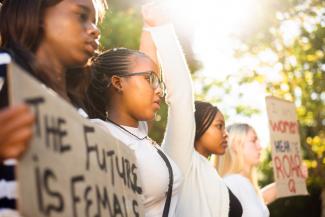
Instructions
Do the preparation task first. Then read the article and do the exercises to check your understanding.
What is International Women's Day?
International Women's Day takes place every year on 8 March. It is an opportunity to celebrate the achievements of women and to create positive change for women and girls. All around the world, people are demanding gender equality and protesting about situations where women do not have basic rights and freedoms. International Women's Day is a time to do this work together.
How did International Women's Day start?
International Women's Day started with a protest that took place in New York City in 1908. Fifteen thousand women went out onto the streets to demand equal rights and better working conditions. In particular, they wanted shorter working hours, better pay and the right to vote.
At the International Conference of Working Women in Denmark in 1910, a woman called Clara Zetkin proposed the idea of an international day for women. Everyone agreed it was a good idea to use the same day every year to take action for women's rights. The first International Women's Day happened the following year, in 1911.
Why do we need an International Women's Day?
People participate in International Women's Day in many different ways and for many different reasons. But a common goal is gender equality.
In today's world it may appear that women have all the same opportunities as men. But if you look at the statistics worldwide, talk to women and girls around you or simply live in the world as a woman, you see this is not true.
There are many examples of women and girls having a lower position in society than men and boys. They have fewer opportunities and they suffer specific injustices and problems because they are women. Here are some examples. Did you know that, around the world:
- teenage girls aged 10 to 14 are twice as likely to do more than 21 hours a week of housework as boys of the same age
- nearly a quarter of teenage girls aged 15 to 19 are not in school, compared to only 13 per cent of boys
- less than half of the world's countries offer girls and boys equal access to education
- many more girls than boys are married while they are still children
- child marriage often means stopping school, getting pregnant early, isolation and an increased risk of violence
- one in five teenage girls have experienced violence from their partner?
Many people believe situations of gender inequality like these can and should be changed.
What happens on International Women's Day?
On 8 March there are protests and other events to demand equal rights for women. You can find marches, talks, workshops, film and music events and more, near you or online. Many people wear purple, a colour worn by women who campaigned for women's right to vote. In some countries, children and men give presents, flowers or cards to their mothers, partners, sisters or other women they know.
The future
There is still a lot of work to be done for gender equality. Sometimes we lose important rights and go backwards with the progress we have made. But women's movements all over the world are still fighting for equality, and new generations are joining them. The people marching in the streets for equal rights are often young women and their friends. Teenagers are organising and campaigning, telling the world how we should think, behave and treat one another. When it comes to gender equality, what kind of world do you want to live in?
What positive changes for gender equality do you want to see?

Comments